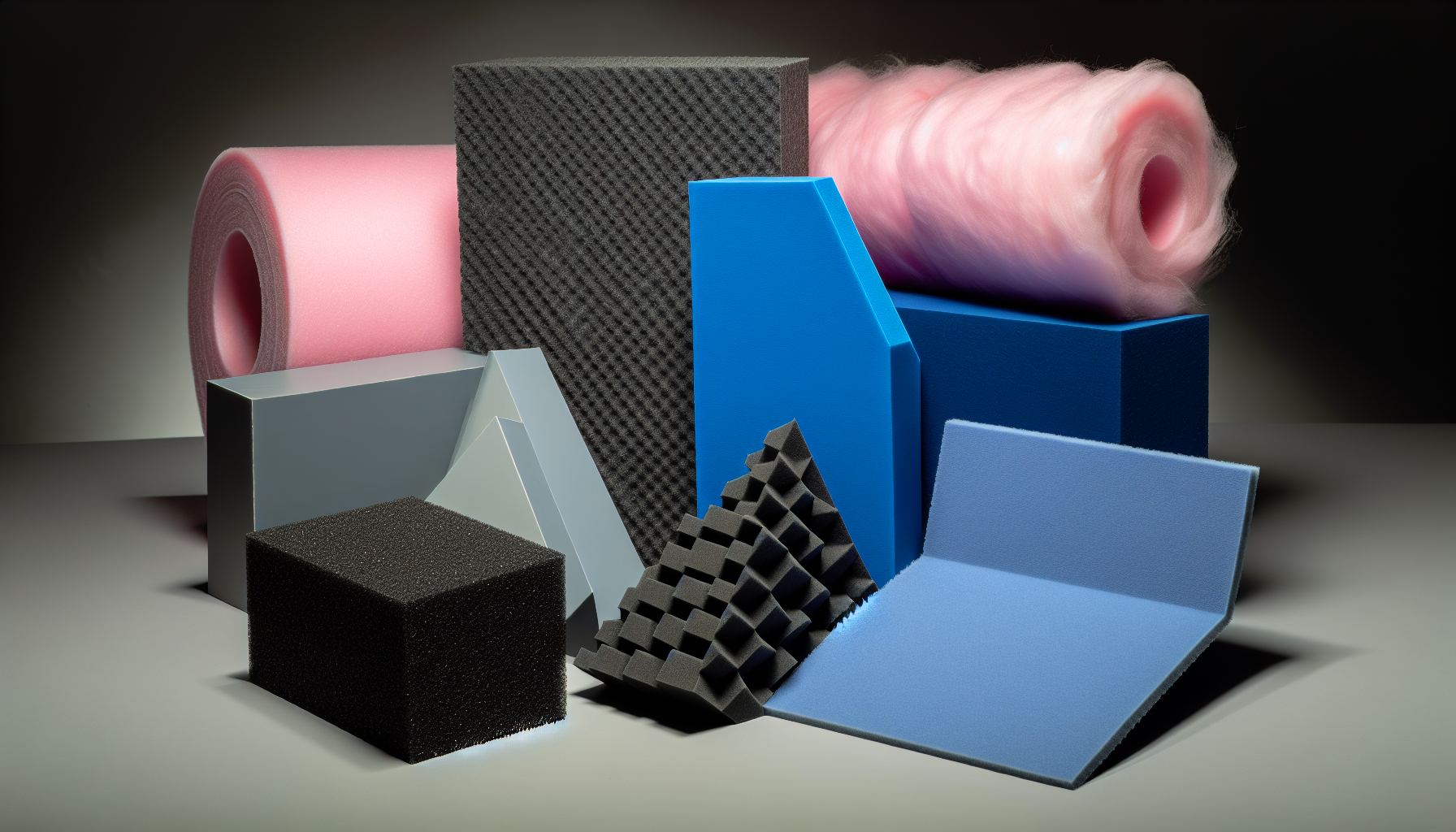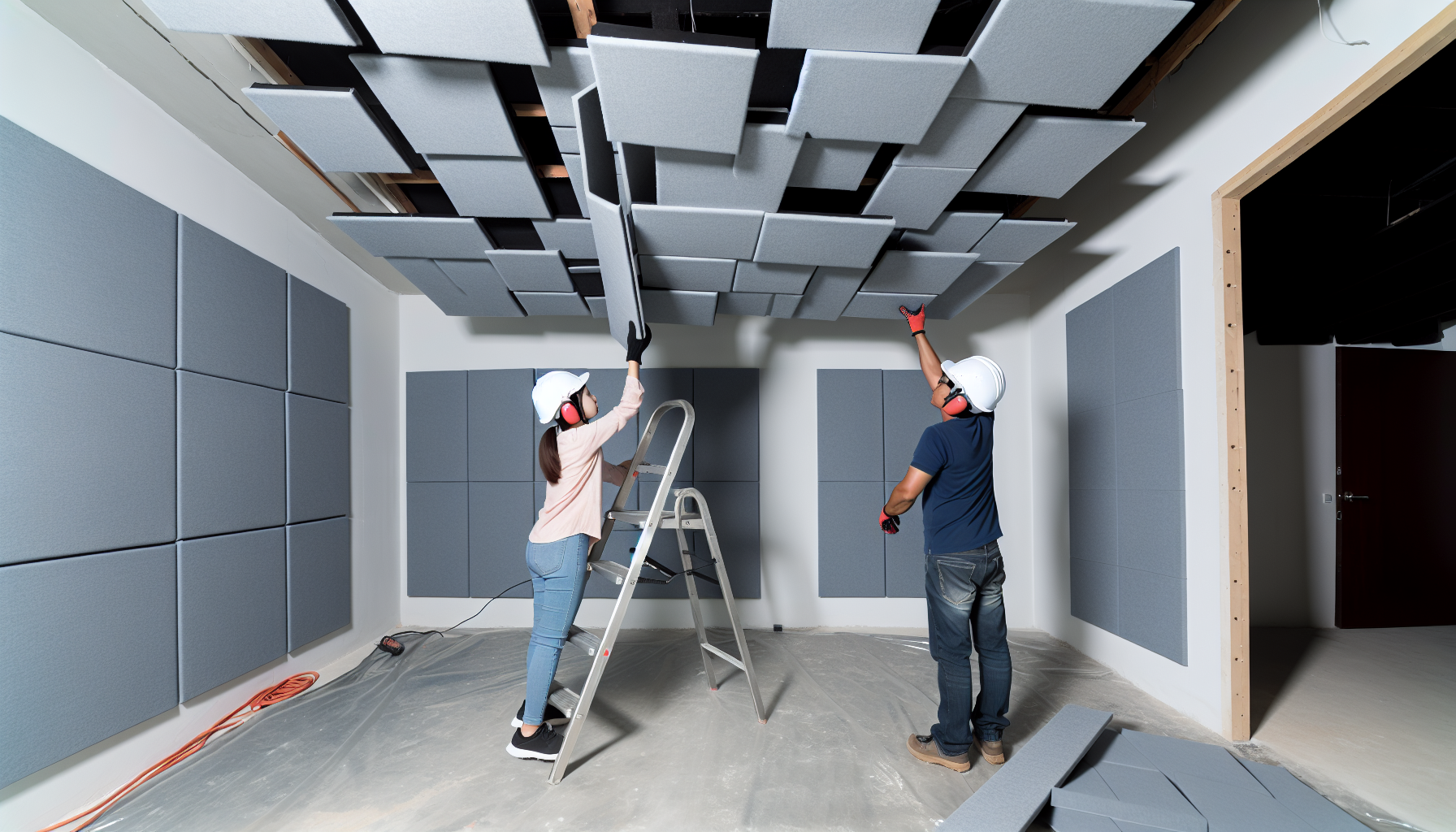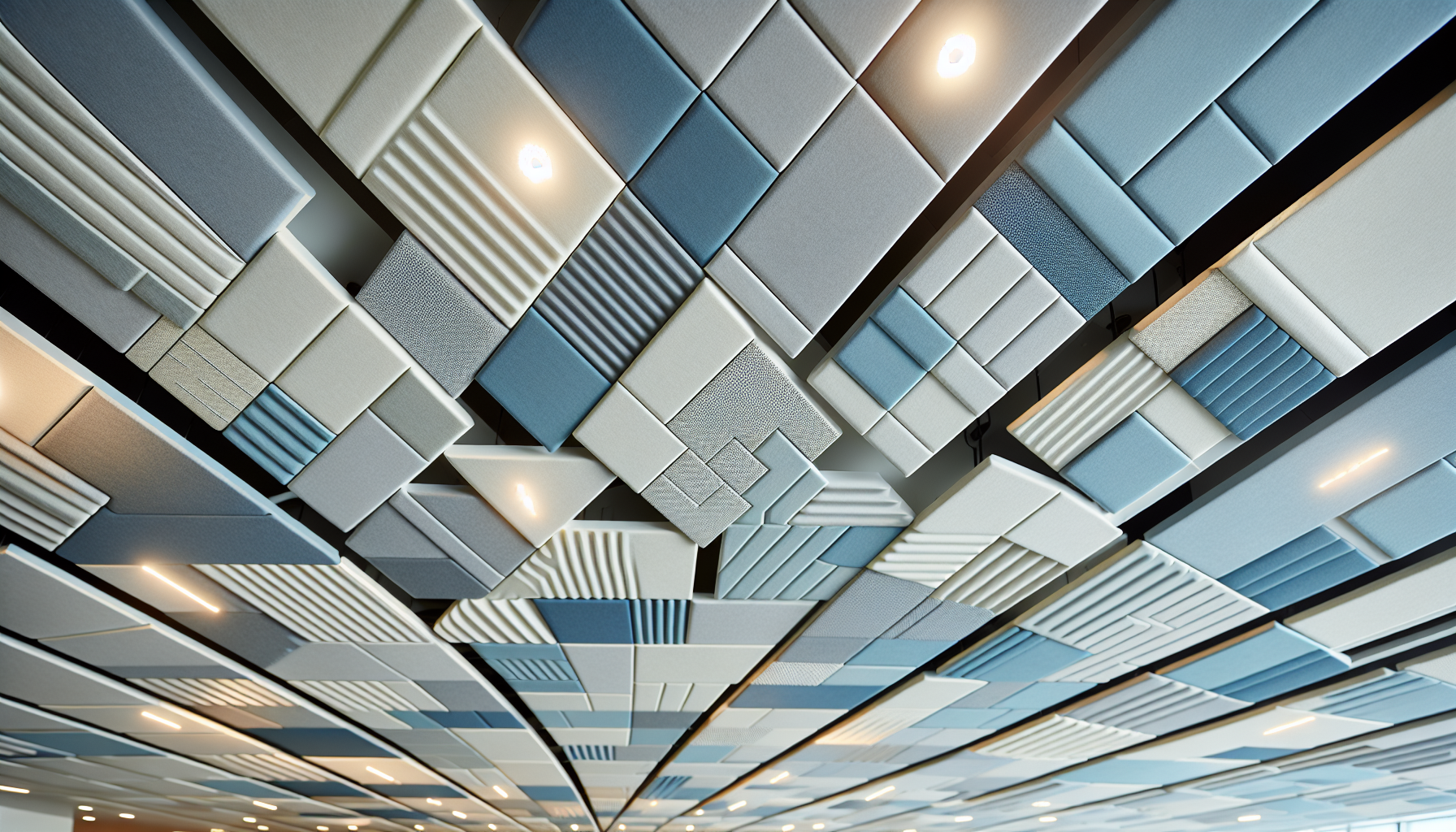

Noise pollution and poor acoustics can undermine the functionality of any space. Discover acoustical solutions tailored to tackle these issues head-on. From absorbing materials to strategic panel placement, our article cuts through the confusion, offering effective methods for sound management in various environments. Dive in to learn how to craft the ideal acoustic setting.
Acoustical solutions are strategic techniques designed to absorb sound waves, reduce noise, echo, and reverberation, enhancing the architectural acoustics and clarity of sound within a space.
Sound absorbing materials convert sound energy into heat, with effectiveness influenced by material properties, and strategic placement is essential for maximizing sound absorption and controlling noise transmission.
Acoustic panels come in various types and materials, with tailored solutions necessary for specific environments such as recording studios and open-plan offices, considering factors like room purpose, size, shape, and acoustical requirements.

Acoustical solutions, a term that might sound like a tongue twister, are actually a lifeline for anyone seeking better sound quality. These solutions are not merely products; they are strategically designed techniques to:
Manage and enhance sound quality
Minimize noise
Diminish echo
Enhance the architectural acoustics of a space.
You might wonder, how do these solutions function? Time to uncover the science that powers these techniques. The magic lies in their ability to absorb sound waves rather than reflecting them. Picture a porous sponge soaking up water - that’s precisely how acoustical solutions work. They are designed with materials that allow sound frequencies to enter and get absorbed, preventing the sound waves from bouncing back into the room.
This absorption of excess sound and reduction of reverberation leads to clearer speech and music, effectively blocking unwanted noise and enhancing the intelligibility of sound within a space.
The functioning of sound absorbing materials is rather fascinating. They play with the physics of sound, converting sound energy into heat, thereby reducing the amount of sound that gets reflected back into the space. This not only helps in minimizing echo and reverberation but also enhances the sound quality within the room, providing a secure connection to the site. However, it’s not as simple as it sounds.
The effectiveness of sound absorbing materials is influenced by various physical properties such as:
Fiber thickness
Density
Porosity
Material structure
Moreover, the way these materials interact with sound waves also plays a crucial role in determining their effectiveness.
As for the placement of these materials, strategic positioning on walls and ceilings is pivotal. Proper placement can significantly enhance the sound absorption capabilities of these materials, effectively reducing noise transmission to adjacent rooms and managing the reverberations in a space.
In the realm of sound absorbing materials, diversity adds a unique flavor. Here are some examples of sound absorbing materials and their characteristics:
Acoustic foam: It boasts an open and flexible cell structure, which enables it to attenuate airborne sound waves, reducing their amplitude and affecting how sound travels.
Fabric wall panels: These panels are made of sound-absorbing materials and are covered with fabric. They can be customized to match the decor of a room while providing sound absorption.
Fiberglass insulation: This material is commonly used for its thermal insulation properties, but it also has sound-absorbing qualities. It can help reduce noise transmission through walls and ceilings.
On the other hand, fabric wall panels, engineered using dense, porous materials, demonstrate their effectiveness in absorbing sound waves and enhancing the acoustics within a given space. Fiberglass insulation, another powerhouse in the world of sound absorption, diminishes noise by capturing sound. The effectiveness of its noise absorption improves with greater thickness and density of the insulation.
The strategic placement of sound absorbing materials can be likened to the strategic moves in a game of chess. It requires careful thought and planning. General guidelines recommend placing these materials symmetrically within a room, taking into account wall length and room features such as lights, grids, and doors for spacing. Placing the materials at the back of side walls is often a highly effective location.
The benefits of strategic placement are manifold. It reduces reverberation and unwanted reflections, leading to enhanced speech intelligibility and a more enjoyable sonic environment. By hanging fabric on walls and positioning absorptive materials at strategic locations, sound wave buildup is minimized, and the balance between absorption and reflection is maintained to create a lively yet controlled acoustic space. The cherry on the cake is that the effectiveness of absorbing materials can be maximized by optimizing their placement based on the position of the sound sources.
Some key benefits of strategic placement include:
Reduced reverberation and unwanted reflections
Enhanced speech intelligibility
More enjoyable sonic environment
Minimized sound wave buildup
Balanced absorption and reflection
Lively yet controlled acoustic space
Maximizing the effectiveness of absorbing materials by optimizing their placement based on the position of sound sources.

For those seeking a serene and pleasant sonic environment, acoustical panels serve as the unsung saviors of advanced noise control. These acoustic panels work by absorbing sound waves and converting their vibrational energy into heat energy. Moreover, they prevent the reflection of sound waves off hard surfaces, thereby controlling noise effectively.
Acoustic panels come in a variety of types, each catering to specific needs. Whether you prefer:
fabric wrapped fiberglass panels
PET/felt panels
foam panels
cementitious panels
perforated acoustic wood panels
the choice is yours. Furthermore, these panels are crafted using a range of materials like Acoustic Fiberglass, Rockwool mineral wool, acoustic foam, and fabrics, to name a few, offering you a plethora of options to choose from.
Selecting the appropriate acoustic panels requires a careful consideration of various factors, including:
Use of fire-rated materials
Durability of the panels
Material of the panels (such as perforated wood)
Type of acoustic panel used
Purpose of the room
Size and shape of the room
Surface material of the room
Positioning of the panels in the room
Key technical criteria such as the Noise Reduction Coefficient (NRC) and fire resistance.
Moreover, the purpose of the room greatly influences the selection of acoustic panels. For instance, a recording studio may require more panels for precise sound control compared to a conference room where some level of ambient noise is acceptable.
Among all, acoustic panels with fabric wrapped fiberglass provide the highest level of sound control. Interestingly, there are distinct acoustic panels designed for specific frequency ranges, making them a versatile solution for a wide array of acoustic needs.
The installation of acoustic panels is a craft of its own. There are several methods for installing these panels to achieve maximum noise control. This includes:
Using impaling clips
Applying adhesive to the back of the panel
Suspending them from the ceiling using adjustable wire hangers
Attaching Z-Clips with screws to the metal plates on the back of the panel
Using adhesive spray
The process involves applying adhesive in a zigzag pattern across the center and around the perimeter of the panel, pressing the panel firmly against the wall, checking for level and alignment, and holding it in place briefly to ensure the adhesive bonds properly. Alternatively, acoustic panels can be mechanically fastened by using impaling clips or Rotofast Snap-On Anchors.
To make this process a breeze, you’ll need a few essentials:
Cleaning cloth
Level
Pencil
Cordless drill
Stapler
Scissors
Folding ruler
Appropriate mounting systems such as impaling clips, Z-clips, or Rotofast Anchors.

Just as superheroes bring a myriad of benefits to their world, acoustical ceilings offer a plethora of aesthetic and functional advantages in the realm of acoustics. These ceilings are typically constructed from a range of materials including:
Reinforced gypsum tiles
Acoustic foams
Polyethylene felts
Fiberglass
Mineral wool
Foam
Wood
Polyester
Mineral fiber
Among these, foam panels generally exhibit lower sound absorption capabilities compared to fiberglass or mineral wool, which are favored for their superior sound absorption properties in ceiling panels.
But the advantages of acoustical ceilings don’t stop at sound absorption. They also contribute to energy efficiency by improving lighting efficiency, enhancing HVAC operations, and providing better thermal insulation. Consequently, they help reduce heat loss or gain, leading to significant decreases in HVAC energy expenses and overall consumption in buildings.
As a bonus, acoustical ceilings, particularly when utilizing suspended ceiling systems or drop ceilings, provide an efficient means to hide infrastructure such as:
pipes
conduit
wiring
ductwork
This makes them a favorable choice for numerous construction projects.
Each ceiling panel material boasts distinct sound absorption and noise-blocking features. Let’s take a closer look at mineral fiber, fiberglass, and metal ceiling panels.
Mineral fiber (stone wool) is generally regarded as having better sound absorption capabilities compared to fiberglass.
Both mineral fiber and fiberglass ceiling panels are efficient in absorbing sound waves and preventing sound from reverberating.
Metal ceiling panels can also offer effective acoustical control.
However, the selection of material for ceiling panels doesn’t just impact the acoustics. It also influences the overall aesthetics of the space. Thus, it’s crucial to strike a balance between aesthetics and sound control. Considering factors such as:
color and finish
materials
size
acoustical properties
fire resistance
maintenance
sustainability
Achieving this balance can be made possible through a secure proceeding, ensuring an optimal site connection.
Incorporating acoustical ceilings into a design is comparable to assembling a jigsaw puzzle. It requires considering a myriad of factors such as room layout, desired aesthetics, and acoustic performance requirements. The design of acoustical ceilings is influenced by acoustic performance requirements, which encompass the management of factors such as noise transmission, speech intelligibility, and overall sound quality.
Moreover, the layout of the room can also impact the design. The presence of low ceilings in a space can result in challenges related to sound reflections and echoes, which can have a detrimental effect on the overall audio experience. Therefore, recommended design strategies for integrating acoustical ceilings into various room layouts include:
Use of sound-absorbing materials
Implementation of sound insulation
Consideration of room shape and layout
Conducting an acoustic audit of the space
Planning to absorb and block excess reverberations.

Soundproofing, often referred to as the champion of tranquility, comprises various techniques designed to block sound waves from traversing through materials, thus preventing unwanted noise from infiltrating or escaping a specific area. Its significance lies in its ability to establish a serene and regulated acoustic setting.
But how do you implement soundproofing? There are several techniques that can be employed. For walls, this involves incorporating sound absorption material within the walls, ensuring airtightness, and enhancing wall mass. For ceilings, soundproofing can be accomplished by inserting a vinyl dampener between layers or utilizing vibration-resistant materials to separate the ceiling structure.
The materials commonly used for soundproofing include:
Mineral, rock, or stone wool insulation
Heavy tapestries
Blankets
Soundproofing spray foam
Mass-loaded vinyl barriers
Acoustic caulk
Soundproof panels
There is an abundance of soundproofing techniques available for walls and ceilings. They include:
Adding mass to the walls, floor, and ceilings
Decoupling the structures
Using materials with high mass and density
Implementing sound dampening
Minimizing sound sources
Furthermore, the effectiveness of soundproofing techniques is not just determined by the materials used but also by how they are installed. Sound damping, a method employed to diminish sound vibrations by transforming them into negligible levels of heat, aids in isolating sound across various frequencies. Another effective technique is decoupling, a process that separates the two sides of a wall or ceiling, making it more difficult for sound to pass through and enhancing the soundproofing performance. By understanding how much sound these techniques can block, one can make informed decisions about their soundproofing needs.
Materials frequently used for soundproofing walls and ceilings include cellulose insulation, mineral or rock wool insulation, and cellulose acoustic panels.
The impact of soundproofing on room acoustics can be substantial. It intercepts frequency waves before they reach the ears, thereby diminishing the overall sound transmission into or out of the room. Additionally, it influences the acoustic energy in a room by absorbing a portion of the sound, potentially enhancing the sound quality within the space.
Soundproofing offers a host of benefits, including:
Improving acoustic quality by minimizing external noise interference
Preventing sound leakage
Reducing unwanted echoes and reflections
Maintaining privacy
Reducing stress or anxiety
Preventing hearing damage
Enhancing sleep quality
Despite these benefits, it’s important to note that soundproofing may not entirely block all noise. To improve the efficacy of soundproofing, sealing cracks and using window inserts can be effective in minimizing noise leakage.
Each environment, whether a recording studio or an open-plan office, presents distinct acoustical challenges. These challenges require tailored solutions that not only address the specific needs of the space but also enhance its overall acoustics. For instance, recording studios face acoustical challenges such as bass response, monitor positioning, management of phase issues, and optimization of acoustics. These can be addressed by employing customized acoustical solutions such as mobile acoustic walls, sound absorbers, resonators, diffusers, soundproofing panels, resilient channels, and multiple layers of drywall.
Similarly, open-plan offices face their own set of acoustical challenges, including echoes, flutter, and increased reverberation times, all of which can have a negative impact on sound quality within the space. Customized solutions for these spaces encompass the use of soundproof walls, acoustic panels, wall tiles, and fibrous materials for ceilings and floors to reduce noise reverberation and improve sound absorption.
Within the realm of recording studios, acoustical considerations hold supreme significance. These considerations include:
Sound isolation: crucial in achieving an optimal recording environment as it allows for the control of reverberation time, reduction of external noise, and the achievement of optimal sound quality for recording or broadcasting purposes.
Absorption: helps to reduce unwanted reflections and echoes within the studio, resulting in a cleaner and more focused sound.
Diffusion: helps to scatter sound waves and create a more balanced and natural acoustic environment.
These considerations are essential for creating a professional and high-quality recording space.
Moreover, the types of sound absorbing materials used also play a crucial role. Preferred materials for recording studios include:
Cork
Recycled rubber pads
Specially engineered underlay
Vinyl sound barriers
Acoustic foam
Another crucial factor is diffusion. In a recording studio environment, diffusion operates by dispersing the sound, reducing the sound’s intensity and creating an optimal recording environment.
In the context of open-plan offices, acoustics frequently become the focal point. Research has shown that the level of background noise in an open-plan office can lead to:
a 66% reduction in productivity
increased stress
deteriorating mood
decreased employee performance
Acoustical challenges in open-plan offices include noise from telephone calls and discussions among co-workers, which can be distracting due to the nature of the conversations. Moreover, background noise frequently diminishes speech intelligibility and adds to a lack of privacy. To address these challenges, sound absorbing materials and placement strategies can be employed. These may include acoustic wall panels, strong insulating barriers like Quiet Batt™ 30, soundproof partitions, stud and glass walls, soft noise dampening ceiling tiles, and a wall-to-wall acoustic ceiling.

In the quest for optimized acoustics, diffusers and reflectors serve as hidden allies. They operate by scattering sound waves and controlling reflections, particularly in large spaces like concert halls. Diffusers function by evenly scattering sound energy throughout the listening space, while reflectors work to optimize the strength and timing of reflected sound to all audience locations].
These devices offer a host of advantages. They avoid sound energy absorption, preserve sound wave integrity, prevent excessive room deadness or dryness in sound, and provide acoustical intimacy, clarity, and enhanced sound intensity. Depending on the specific requirements of the space, a variety of diffusers and reflectors can be used, including Skyline Sound Diffusers, Quadratic Residue Diffusers, 2D Quadratic Residue Diffusers, Barrel Sound Diffusers, Pyramidal Sound Diffusers, and Acoustic reflectors.
Diffusers hold a key role in amplifying room acoustics. They work by dispersing sound waves across a larger area to mitigate acoustical challenges such as echo and reverberation. This is achieved by scattering sound waves in various directions, thereby enhancing spatial resolution and diminishing the impact of sound reflections.
The efficacy of diffusers is not just dependent on their design but also the materials used in their construction. Typical materials utilized in the construction of sound diffusers include wood, plastic, and foam. These materials are selected for their ability to effectively scatter sound waves.
Reflectors significantly contribute to augmenting the audience’s auditory experience in concert halls. They work by:
Facilitating a combination of direct sound and reflected sound
Contributing to the attainment of an ideal reverberation time
Ensuring efficient direction of sound from the stage to the audience.
Reflectors used in concert halls, such as the ones found in a concert hall, are often constructed using materials such as:
plaster
wood
concrete
metal
glass
plastic
Their placement also has a significant impact on the acoustics of the hall. They are usually strategically placed on the side walls and overhead, while also avoiding excessive reflections.
In conclusion, creating an ideal acoustical environment is not a matter of chance, but a result of careful planning and execution. Whether it’s through sound absorbing materials, acoustic panels, acoustical ceilings, soundproofing, or the use of diffusers and reflectors, each element plays a crucial role in achieving the desired sound quality. So, the next time you find yourself struggling with acoustical challenges, remember that the solution lies not in enduring the noise but in enhancing the silence.
Acoustic solutions are designed to absorb or diffuse sound to improve the acoustic quality of a space, reducing noise levels and creating a more comfortable environment for conversations and activities.
The three main elements of acoustic treatment are bass traps, diffusers, and absorbers. Bass traps help absorb low frequencies, diffusers break up focused reflections, and absorbers reduce reverberation and echo in a room.
The solutions for acoustic protection include bass traps, which are designed to absorb bass sounds in room corners, and acoustic fabric panels placed along the walls to absorb excessive sound reverberation. Consider implementing these solutions to improve the acoustic environment in your space.
An example of an acoustic treatment is the use of acoustic foam sheets, absorption panels, bass traps, sound blankets, and insulation in sound studios. Avoid overusing these treatments in order to achieve balanced acoustics in a room.
An act ceiling, or acoustic ceiling tile (ACT), is made of materials like foam and wood to absorb sound and reduce echoes and noise, preventing reverberation from disturbing conversations.